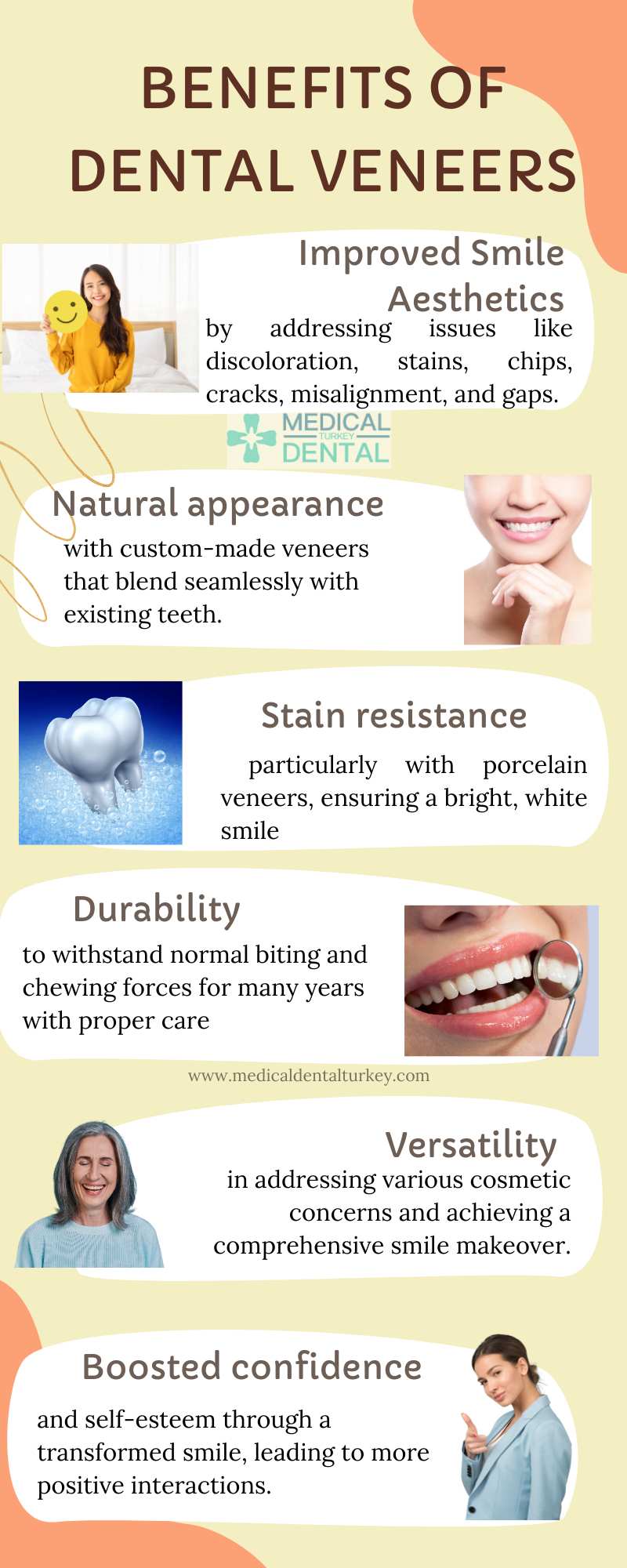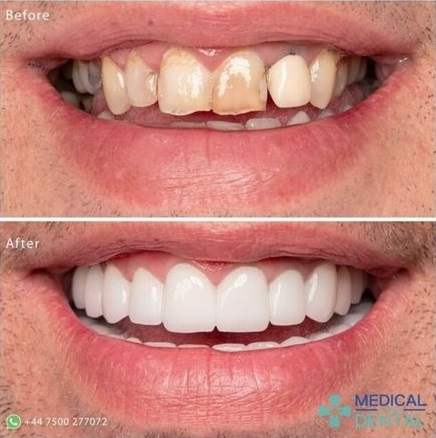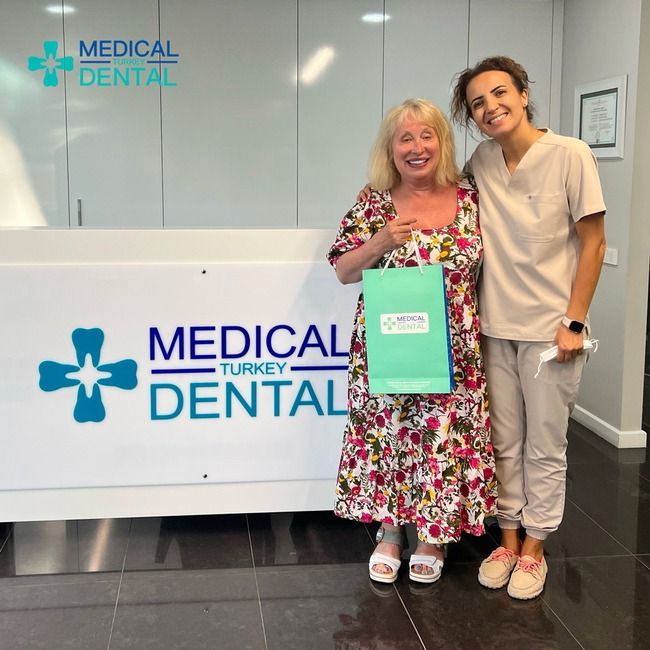Dental Veneers in Antalya,Turkey
Dental veneers are thin and functional covers of cosmetic dentistry that are employed when changing the color, shape, and size of a tooth, and require minimal abrasion on the tooth surface. The veneer covers the front of the tooth like a fingernail and overlaps the edge, so the bulk of the tooth remains intact. There is little or no need to reduce or prepare the tooth.

First invented by Dr. Charles Pincus -a dentist of Hollywood celebrities, veneers now are available to everybody. With the invention of bonding techniques in 1980, it became almost impossible to distinguish them from natural teeth. The dentist and ceramic technician use their artistry and skill to make and shape the porcelain veneers. In essence, the skill of these two pairs of hands is the most critical factor in making them look natural.
With more than 100 years of background in modern dentistry, Turkey can be the address of the skillful hands you are looking for. By including this country in your clinical research, you can buy high-quality services at highly reasonable prices and combine your dental treatment with a magnificent holiday.
What are Dental Veneers?
Dental veneer treatment, as the name suggests, is the restoration of the teeth with different materials in which teeth lose substance for various reasons or are made for aesthetic purposes. Dental veneers improve the appearance of teeth by covering their front surfaces with thin, tooth-colored shells. They are usually made with porcelain or resin composites that are permanently bonded to the teeth.
Due to their easy application and low cost, acrylic and composite veneers were in demand. However, since acrylic and mixed resins are not long-lasting and coloration, abrasion, and marginal fractures occur, porcelain and zirconia (a kind of porcelain produced from zirconium) are now preferred as veneer materials.

Benefits of Dental Veneers?
There are many essential benefits of getting a dental veneer. However, the most important benefits of veneers include aesthetic factors such as improving the appearance of your teeth and getting a brighter and more beautiful smile, etc. Here is a list of their most important benefits.
- Veneers on your tooth provide a natural look,
- Veneers are resistant to stains; can be whiter than your natural tooth color,
- Both porcelain and zirconia veneers tolerate tooth tissue well.
- They cover cracks, chips, and discoloration,
- Veneers, especially laminate veneers, require little enamel extraction from the tooth surface,
- Dental veneers boost your confidence,
- They require low maintenance as they are made with stain-resistant materials. Only regular brushing and flossing are enough to keep them clean.

Who Is the Best Suitable for Dental Veneers?
Veneers are an attractive solution if you want to rejuvenate their smile. Due to improvements in dentistry, veneers are so popular among those with relatively minor impairments in their smiles. Now we can take a look at who is suitable for this treatment.
- If you have healthy gum and teeth,
- When your teeth are chipped, cracked, discolored, or slightly misaligned,
- You should have realistic expectations for what veneers can do. There is no magic bullet to fix every dental problem with veneers, and they are not a cure-all.
What Are Dental Veneers Types?
Veneers are generally analyzed in two groups. Composite veneers and porcelain veneers.
Composite veneers are called temporary veneers and have an average lifespan of 3 to 5 years. They are preferred because they are inexpensive and do not require abrasion on the tooth surface. They are also a reversible solution for those who may want to return their prior smile.
Porcelain is the primary material of all veneers produced in the laboratory environment. Today, porcelain veneers are presented in a huge number of different types. We can index them in basic 3 groups.
Empress Veneers (Emax Veneers)
Empress veneers are produced by strengthening porcelain with metal crystals. They are known as Emax veneers as the producer company Ivoclar Vivadent named them. Since their light transmittance is quite well, they are in perfect harmony with the teeth and only require 0.3-0.7 mm abrasion from the tooth surface. Emax veneers are produced as a single block, so their resistance to breakage is higher. They have an average resistance force of 500 Mpa.
Zirconia Veneers
Zirconia veneers are as aesthetically beautiful as Emax and laminate veneers. They can also last an average of 20% longer than Emax veneers. The biggest disadvantage of zirconia veneers is that they require more abrasion on the tooth enamel than Emax veneers. Zirconia veneers require 0.7 to 1mm abrasion on the tooth surface and have a resistance force of 900- to 1100 Mpa.
Laminate (Lumina) Veneers
Lamine Veneers attach to the enamel layer without penetrating the dentin area of the tooth. Therefore, no more than 0.4 mm abrasion can be made. Due to these features, they are skinny, like a finger lens, and provide minor damage to the tooth.

How Is Dental Veneer Treatment Done?
The decision for veneer treatment must be made jointly by the dentist and the patient. If you've decided that veneers are the best treatment for you, let's take a look at what awaits you in the following stages.
Consultation
This is the most important stage that affects the success of your dental treatment. In this session, the dentist will take panoramic X-ray and 3D pictures of your teeth and conduct a detailed examination for your treatment. However, the patient should accurately transfer his expectations to the dentist for the success of the treatment.
Tooth Preparation
At this phase, small restorations are made on the teeth in line with the patient's prospects. After this stage, composite bonding can be applied to the teeth.
- Patient bite impressions are taken and sent to the lab to make a mock-up (trial set of veneers).
- The lab prepares a wax model to make sure the patient loves the shape and length of the veneers, and his smiling,
- After deciding on the correct smile, and veneer shapes with the patient, the measurement is retaken for permanent veneers, and the production stage is started. In most clinics, patients can wear permanent veneers on the same day using CAD-CAM technology.
- The patient is given an appointment for 4-5 days later. After the final cleaning procedures on the tooth surface, abrasion is made according to the type and thickness of the veneer. And the dentist bound the veneers to the teeth surface.
How Long Dental Veneers Last?
Dental veneers have an average life span of 10 to 20 years. The type of dental veneer dramatically affects how long it will survive. However, especially in smokers, the rate of discoloration on dental veneers is quite high, and they need to be replaced even if they are robust. Now let's look at the results of scientific research on different types of veneers.
E max Veneers --> %70 survival rate over 15 years, %93 over 10 years,
Zirconia Veneers --> %78 survival rate over 15 years, %88 over 10 years,
Laminate Veneers --> %93,5 over 10 years.
How Much Do Dental Veneers Cost?
Since veneers are made for aesthetic purposes, they are not included in health insurance. For this reason, many people from countries where treatment is expensive, such as UK, Germany, and the USA, prefer more affordable countries such as Turkey and Mexico.
| Cost (Veneer per tooth) | USA | UK | Germany | Turkey |
| Porcelain | $900-$1600 | £600-£1000 | €600-€1000 | €150-€330 |
| Composite | $600-1400 | £400-£800 | €300-€500 | €100-€200 |
| Lumineers | $750-$1800 | £600-£950 | €550-€1500 | €200-€280 |
| Emax | $850-$2500 | £700-£1400 | €650-€1200 | €200-€280 |
| Zirconia | $800-$2000 | £650-£1200 | €550-€1100 | €200-€280 |
It can be confirmed from the table that dental veneers in Turkey offers %70 more affordable prices.
Veneers Cost in Antalya,Turkey?
The number of teeth to be treated in dental veneer treatments is usually between 16 to 20, and some orthodontic and aesthetic surgeries may be needed so that the patient may face very high charges in total. Below you can see how big differences occur between UK and veneers Turkey costs. The dental veneers prices are not included such costs as implant treatments, orthodontic surgeries, and aesthetic surgeries.
| UK Veneers Prices | Turkey Veneers Prices (The prices are included Hotel, breakfast, and transfer which takes about £800 for one week) |
| 16 veneers are £14000 | 16 veneers are £4500 |
| 18 veneers are £16100 | 18 veneers are £4800 |
| 20 veneers are £17900 | 20 veneers are £5200 |
At Medical Dental Turkey, we are committed to providing comfortable and honest dental care to our patients with compassion, dignity, and consideration. By listening to your needs and getting to know you, we aim to build lifelong relationships based on trust and mutual respect.
Dt. Zehra Ugur Nalbantci's primary principle is to provide gentle yet excellent quality dentistry through hours of expertise and keeping up with the latest procedures. We only use the best dental materials to provide long-lasting smiles.
Why Choose Turkey for Dental Veneers?
When the first faculty of dentistry was opened at Istanbul University, the calendars were showing 150 years ago. Since then, Turkey has always been among the pioneering countries in the field of dental health. Dentistry has been in such high demand in Turkey that to become a dentist, students must enter the top 25 thousand out of 2 million. Then 5 years of challenging training and 2 years of clinic experience.
This high-quality education in Turkey has led to the birth of sophisticated dental clinics. In recent years, Turkey, which provides affordable price advantages with the tax advantages offered by the government, has become the fastest growing country in dental tourism.
Located very close to Europe, Turkey also offers great holiday opportunities for patients. Those who prefer Antalya-the biggest touristic city in Europe for their dental treatment, can find many opportunities to get away from the stress of their treatment.
How Long A Stay in Turkey for Veneers?
The Porcelain veneers Turkey treatments are usually applied in two sessions which last about a week on average. Although these treatments can be performed in a single session using the CAD-CAM technology, the application in two or three sessions allows dentists to evaluate possible errors better.
Why Are Veneers Cheaper in Antalya,Turkey?
Turkey offers very reasonable prices in every field of health. We can list the main reasons for this as follows.
- In dental treatments, 70 percent of the treatment cost is paid to the doctor and the clinic, while only % 30 is paid to the equipment and materials. The fees charged by clinics and dentists are much cheaper in Turkey than in Europe,
- In Turkey, the government makes excellent reductions in taxes on the treatment of foreign patients to attract more health tourists,
- The average monthly expenses (personnel, electricity, heating, etc.) of a clinic in Turkey are much more affordable than in other European countries.
- Dental tourism in Turkey is growing above the world average. This leads to high competition in the field of dental tourism. Clinics use the latest technology and materials to stay in this competition and make their prices as affordable as possible.
Risks of Dental Veneers
Although there are no risks that threaten our lives, veneers also carry risks that you should be aware of.
Tooth Sensitivity;
During the treatment, the dentist scrapes a little on the tooth enamel and there is a sensitivity to very cold and scorching drinks. However, this sensitivity is expected to disappear entirely in about three weeks. If the sensitivity in your teeth continues after 3 months, you should consult your dentist. There may be a chance that the dental nerves become infected during treatment.
Irregularities in Color
After a certain period, the cement applied in veneer treatments may cause different color formations on the tooth edges, which is the leading cause of discolorations.
Gum Tissues Can’t Properly Adjust
The gums need to adapt to your new veneers; if your swelling does not go away in a week, contact your dentist.
Higher Risk of Trauma
In dental treatments requiring a high abrasion, the pulp inside the tooth may be damaged and completely dead. To prevent this infection risk, it will be a healthier option to apply a crown.
Dental Veneers - FAQ
Is the Procedure Painful?
Veneer treatment is performed under local anesthesia. The patient doesn't feel any pain or soreness during the treatment other than the vibration of the tolls and the interventions of the dentist.
Are Veneers Covered by Dental Insurance?
Since veneer treatments are considered for aesthetic purposes by insurance companies they are not covered by insurance.
Are Dental İmplants and Veneers the Same Thing?
Both are entirely different things. Implant treatment is the process of creating an artificial tooth in place of a lost tooth. On the other hand, veneer treatment is the process of coating the tooth surface to give a more aesthetic appearance.
How to Remove Dental Veneers?
Dentists can remove veneers with dentistry methods or by using a laser. However, the removed fronts should be replaced with new ones. Because of the abrasions on the tooth surface, the teeth no longer regain their former appearance.
Do Dental Veneers Damage Your Teeth?
Dental veneers are attached to the tooth surface by scraping enamel. That's the only damage dental veneers cause. Other than that, there is no loss in the strength and functions of the tooth.
Dental Veneers or Crowns?
Both treatments are applied with different requirements. While veneers are employed to correct more minor dental disorders, crowns are used to address relatively large dental problems. When crown treatment is applied, the teeth lose their prior functional properties because of the extensive trimmings on the tooth surface.
Why Do I Need Dental Veneers?
Dental veneers can be used to:
- Cover cracked, discolored, or misaligned teeth,
- Improve the appearance of your smile and provide a more aesthetic appearance,
- Achieve a flawless, natural, and long-term appearance.
- Veneers can also protect weakened teeth, boost self-confidence, and add durability.
How Many Veneers Do I Need?
The number of veneers you need will depend on how many teeth you see when you smile. This will require an interview and consultation with your dentist.
If you only have one problem, a single veneer will be enough. But if you need more, you may need additional veneers to achieve a more aesthetic and balanced look. Depending on the situation, you may need 4-8 veneers or more.
How Should I Care for My Veneers?
Caring for veneers is simple:
- Brush, floss and go for regular check-ups just like you would your natural teeth.
- Avoid biting hard, crusty foods to prevent possible damage.
- Limit foods and drinks that stain, such as coffee and red wine.
- Good oral hygiene and regular visits to the dentist will ensure that your veneers remain in excellent condition for many years to come.
